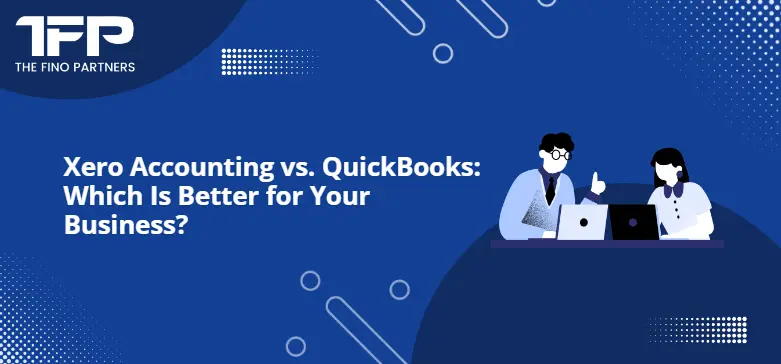Our comprehensive research indicates that QuickBooks is the superior choice. It is mainly for US businesses. With its advanced feature package, robust support tools, and standout examining capabilities, QuickBooks provides a secure and well-equipped platform for your accounting needs. Xero may be more affordable. But both providers offer comparable features for bookkeeping, accounts receivable, etc. It decides between the two challenges. Both Xero accounting vs QuickBooks performed exceptionally well in our testing. QuickBooks earned a high score of 4.7 out of 5 from our accounting expert. It is compared to Xero's 4.5 out of 5. These impressive scores are a testament to the quality of these accounting tools. The high scores indicate that Xero and QuickBooks are efficient tools for managing your business's finances. After all, it is mainly for US businesses. This article deals with finding the best accounting software for US businesses.
Xero vs QuickBooks: Basics
Xero and QuickBooks are solutions with great tools for core accounting needs. It involves bookkeeping, account receivable tracking, etc. QuickBooks offers a more seamless experience for two significant reasons. Firstly, it provides phone support, a feature not available in Xero, allowing QuickBooks users to resolve issues more quickly. Secondly, QuickBooks offers some unique features, such as document scanning. It is a feature that Xero needs to improve. However, Xero's lower starting price of $13 per month. This is compared to QuickBooks' $30 per month. After all, its comprehensive range of integrations may make it a more appealing choice.
Xero vs QuickBooks: A Comparison for Your Business
Xero vs QuickBooks offer many features. It involves all the essential abilities that make these two options the best US business accounting software. Our comparison of the core features provided by Xero vs QuickBooks is comprehensive and detailed. This comparison will help you understand the strengths and weaknesses of each software, allowing you to make an informed decision based on your business needs.
1. Tax Tools
Both Xero and QuickBooks give tax preparation characteristics, and that characteristic is just one reason why our researchers gave both assistance a perfect 5/5 for financial reporting. All QuickBooks plans can let US businesses track sales tax and manage 1099 contractors, except the Self-Employed plan, which helps freelancers estimate their quarterly taxes. Moreover, all plans give tax deduction maximization tools. They are creating it to let an account and see the books. It also allows all users to export documents, group income or expenses by tax class, and automatically sort each new cost into the correct tax category.
Like QuickBooks, Xero can estimate sales taxes for each invoice automatically. A tax default can be set for any purchase, and Xero gives integration with Avalara TrustFile to help you point out/file your returns. Xero's tool also lets you map your accounts to various classes of revenue forms, keeping everything organized.
2. Expense Tracking
Xero and QuickBooks offer great expense tracking tools, earning each a5/5 accounts payable score from our study. There's one distinction, though: All of QuickBooks' plans let you follow your expenses and sort each into the proper tax classes. But Xero limits expenses to its established plan, with none of this software in its early and growing plans. You can even take photos of your concrete receipts with QuickBooks. The software automatically matches the existing costs. Transactions can be imported from bank accounts and credit cards. It can also be imported from third-party services. It involves PayPal, Square, etc.
Xero's raft of expensing abilities enables you to scan receipts to record and track cost claims. It also slots each expense into the best category for a record. The established plan also assists in a multi-currency process. It converts 160 foreign currencies into your US business’s local currency.
3. Inventory Tracking
Xero provides inventory instruments across all its plans. It marks a step up from QuickBooks. It includes inventory tracking with its Plus and Advanced plans. But it is not with Simple Start, QuickBooks' entry-level plan. With QuickBooks, you can follow particular goods and the value of your products and receive notifications when inventory is low. Managers can quickly generate purchase orders and administrate vendor data from a single location. Inventory information can be imported with Excel and synced with Etsy, Shopify, Amazon, etc.
Xero’s inventory features allow US business managers to do much of the same data logging as QuickBooks: You can follow the profits of each product line. It can be done by spotting the most popular or profitable items. The data can then notify decisions like what to stock and how to change pricing. Stock levels and the value of your products can be automatically tracked. After all, photos can be uploaded for each item, and supplier contracts can be attached for extra documentation. Items can be bulk-imported with a CSV record/document. After all, inventory data is fully integrated with distinct accounting classes. It involves quoting, invoicing, and ordering. This detailed comparison of QuickBooks' and Xero's inventory tracking features will help you decide based on your business's needs.
4. Invoicing and Payments
We consider both Xero and QuickBooks among the best invoicing software for US businesses. Both services earned a 5/5 points score overall in our research's bookkeeping category. QuickBooks holds up six custom invoice templates and lets you follow the invoice status with read receipts. If needed, you can easily send clients reminders and match any payments received with the proper invoice for proper bookkeeping.
You can attach your logo to your invoice templates. After all, you can change the colour to fit your US business's branding. While the Advanced tier of QuickBooks gives 24/7 assistance through live chat, phone lines, and email, their other tiers only provide a live chat option. Xero also lets you send quotes. It also estimates that it can quickly pull up contacts, inventory, and pricing data. You can set cautions to make sure no invoice slips through the cracks. Extra automation abilities let you select inventory things from a preset list, quickly duplicate a previous invoice, or set up automatic invoices for repeat orders. Additionally, read receipts let you know when clients have seen an invoice and if it's been paid. Xero's only client assistance options are an email system and a fact/information base.
QuickBooks operates a first-party payment processor. It means that the cash/money goes through QuickBooks. However, Xero uses third-party processors like PayPal or Stripe. Neither of these is better, but it pays to be aware of the distinctions.
5. Time Tracking
Xero has more expense-effective time tracking than QuickBooks. It is because QuickBooks provides an add-on for time tracking. This starts at $20 monthly (plus $8 per user). But Xero bundles time tracking with its leading aid. The QuickBooks add-on is called QuickBooks Time. It’s feature-heavy and available in two plans:
- Premium, for $20 monthly plus $8 per user per month
- Elite, for $40 monthly plus $10 per user per month
Premium involves scheduling for jobs and shifts, real-time reporting, custom alerts, etc. Elite offers Premium features: project activity feeds for better control, project estimates that can be effortlessly compared with actuals, and support for timesheet signatures. The base price for both plans is half off for the first three months.
Compared to QuickBooks, Xero's time-tracking features are easy to use. You can download the free Xero Projects app on iOS and Android to record time and costs and seamlessly and automatically feed the data into invoices and reports. The cheaper cost of Xero's time-tracking abilities will likely make it more appealing, even if QuickBooks includes more features. However, some US businesses may rely on those features, particularly if they opt for top-down oversight requiring greater control.
6. Payroll Processing
Xero and QuickBooks both provide payroll at different costs. QuickBooks provides employee payroll software as a separate tier of plans:
- PayrollCore is $45monthly, plus $5 per employee per month
- PayrollPremium is $75 monthly, plus $8 per employee per month
- PayrollElite is $125 monthly, plus $10 per employee per month
Core provides the basics, while Premium adds same-day direct deposit, role-based access, and auto-time tracking. Elite also attach tax penalty protection and a dedicated pro to help set up and troubleshoot. Like QuickBooks, Xero does not bundle payroll assistance with its core plan. It has teamed up with a third-party payroll tool, Gusto. Get both, and you can use single sign-on. Also, you get the first three months of Gusto free. After all, you have two plan choices:
- Simple, for $40 per month, plus $6 per employee per month
- Plus, for $80 per month, plus $12 per employee per month
Xero vs QuickBooks: Customer Service & Support
Xero and QuickBooks both have good assistance. It also has training options. However, QuickBooks has phone support, while Xero does not. This earns it a research score of 4.7 – nearly double Xero’s 2.4/5.
1. Online & Phone Call Support
If you're logged into QuickBooks, you can obtain live support online. The live chat is accessible between 6 a.m. and 6 p.m. PT on Monday through Friday. After all, 6 a.m. to 3 p.m. PT on Saturday. Phone assistance is accessible during the same hours.
Xero users do not have any phone assistance options. However, they do have 24/7 online assistance. To get it, you should visit Xero Central and ask a query. You can then follow its progress through a section called "My Cases," which details the status and the expected response time.
Moreover, Xero staffers can call people back to discuss their cases over the phone. It gives you that phone assistance you need, albeit in a roundabout way.
2. Setup and Training Options
QuickBooks has an online portal. The users with common issues can check to resolve any problems without involving customer assistance. It includes blogs and videos arranged by the type of QuickBooks product and further broken down into classes such as 'Account Management,' 'Taxes,' and 'Sales and Customers,' among others. Video training classes, a blog, and a community forum are available.
Xero's assistance and learning portal, Xero Central, gives access to a searchable database classified by topics like 'Inventory' or 'Reporting and Tracking,' among others.
Xero vs QuickBooks: Ease of Use
Both accounting software are easy to navigate, allowing you to find your required features from a basic dashboard with a sidebar. QuickBooks' sidebar is vertical and on the left. But Xero’s is horizontal across the top. Both enable the same user experience, and user satisfaction is high.
The number of customers supported for each aid is one huge difference: Xero assists unlimited users across all plans. However, QuickBooks parcels them out with plans ranging from just one customer to 25 in total. Xero is the best choice for a high or rapidly expanding operation. After all, both assistants can scale up to handle heavy, continual use.
Customization options also differ. Both aids will allow you to modify your main dashboard to display the stats that matter most to you, but QuickBooks gives a little more flexibility.
QuickBooks also takes the lead when it comes to custom reports. Both Xero accounting vs QuickBooks let you set up automated data tracking. But QuickBooks has more granular options. This makes it faster to contrast reports against historical data. It also has more templates. You'll still be able to fulfil everything you need with both. But it'll be a little quicker with QuickBooks.
Closing Remarks
Both Xero accounting vs QuickBooks provide excellent, easy-to-use, and justifiably famous services. After all, both have some disadvantages that the other addresses. Xero only helps administrate costs with some of its plans, even though QuickBooks does. However, QuickBooks needs to manage inventory with its Simple Start plan. But while Xero provides a great raft of features. It involves top-tier invoicing tools. QuickBooks received top marks in five of eight product classes while maintaining better support and advanced tools than Xero. It makes it the best accounting software we've researched and helped it edge out Xero in this round.
Fino Partners provides the full spectrum of consulting, calculation, and compliance. In Fino Partners, your entire process is managed by seasoned professionals. Experts with collective tax knowledge do it from start to finish. Get in touch to work with a transparent business with the expertise to take sales tax off your plate. If you’re curious for more information on these, Contact us today!



























